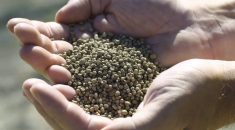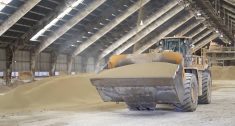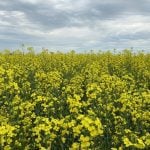Most everybody knows how important 4R nutrient management is. Applying nitrogen and other nutrients from the right source and at the right rate, time and place ensures crops get all of the nutrients they need while also minimizing losses through nitrous oxide emissions.
Many believe 4R nutrient stewardship could also be key to reaching the federal government’s ambitious target for reducing greenhouse gas emissions from fertilizer use by 30 per cent from 2020 levels by 2030. Of course, this requires a major commitment to 4R principles and practices, not just from farmers but from everyone in the ag value chain.
The 4R message is clearly resonating with western Canadian producers. But what’s unclear is exactly how many growers have really taken 4R nutrient management to heart with their farming practices. As it turns out, knowing that number could be vital to the success of not only 4R nutrient stewardship but also reducing environmentally harmful nitrous oxide emissions on farms in Canada.
Read Also

Gentle treatments for pain in the neck
Heading toward year-end, people unknowingly tense up against the cold and busyness, causing neck pain that can often be treated with appropriate support and gentle mobility, athletic therapist Kathlyn Hossack says.
The Canola Council of Canada (CCC), Fertilizer Canada and Agriculture and Agri-Food Canada (AAFC) are banking on a program called Canola 4R Advantage to gauge the level of 4R buy-in from canola producers in Western Canada.
Canola 4R Advantage offers financial sup- port to help producers initiate or advance 4R nutrient stewardship on canola acres, with funding provided by AAFC through the Agricultural Climate Solutions initiative, On-Farm Climate Fund.
The program is focused on best management practices (BMPs) that support increased productivity and profitability for farmers while reducing nitrous oxide emissions. The BMPs offering incentives are in the following four areas:
- Soil testing
- Use of enhanced efficiency fertilizers
- Preferred nitrogen applications (the program will fund a portion of fertilizer costs for growers switching from fall nitrogen applications to spring banding, or from fall nitrogen applications to a split of spring banding and in-crop applications)
- Field zone mapping consulting services for variable-rate nitrogen applications
Participating canola producers are eligible to receive funding for up to two BMPs per year at $6,000 per BMP. To qualify for the incentives, farmers must have a 4R nutrient stewardship plan that has been certified by a certified crop advisor or professional agrologist who has earned a 4R designation from Fertilizer Canada. The idea is by working with designated 4R agronomists and agrologists, farmers can get guidance from certified experts, and they’ll also have their canola acres recognized and accounted for under the 4R nutrient stewardship program.
Canola producers who don’t yet have a 4R nutrient stewardship plan can still qualify for Canola 4R Advantage funding. However, the plan must be completed and verified within six weeks of applying, and the application must identify the 4R designated agronomist they will work with to complete the 4R plan. Producers looking for a qualified certified crop advisor or professional agrologist in their area can visit the Fertilizer Canada website for a listing of 4R designated agri-retailers.
Curtis Rempel, vice-president of crop production and innovation for CCC, says the selected BMPs have a solid body of scientific evidence behind them and they also allow for continuous improvement.
“Some (of the BMPs) are at a beginner level, some are intermediate and some are advanced. Hopefully, farmers will find something that appeals to them in terms of where they are in their 4R journey,” he says.
“The grower can get some on farm experience, which I think is important. It’s one thing to see data and research trials … but experience on the farm is also really important when you’re thinking about adopting new practices.”
Data collection
In addition to offering financial incentives, the Canola 4R Advantage program is collecting data that will help show the progress western Canadian farmers are making in GHG reductions as part of the National Inventory Report (NIR). The NIR contains estimates of Canada’s annual GHG emissions and is required to fulfill Ottawa’s reporting obligations under the United Nations Framework Convention on Climate Change (UNFCCC).
For those questioning Canada’s involvement with something like UNFCCC, Rempel says it’s a no-brainer. “I think Canada as an economically advanced nation has to be at the table showing what we’re doing in terms of contributing to mitigating climate change.”
Some producers are more comfortable than others sharing information about their farming practices, but Rempel says that shouldn’t be a concern for those participating in Canola 4R Advantage. That’s because any program data for public consumption will be reported on an aggregate basis only.
“We’re only concerned about aggregated data — we’re not concerned about which farmer is doing what. Ultimately, the more farmers that participate, the better our aggregated data will be,” says Rempel.
Rempel maintains by having farmers participate in programs like Canola 4R Advantage, “we can start as an industry aggregating our data and showing we are providing information on concrete, verifiable acres being managed to mitigate nitrous oxide losses. We can have an empirical database that we can start working with on our international reporting obligations.
“If we are reporting on fertilizer use, we should also be reporting on mitigation measures that are in place to limit or exclude nitrous oxide emissions. You have to report on that stewardship as well,” he adds.
Rempel maintains by supporting programs like Canola 4R Advantage, the government of Canada aims to generate the verified proof it needs to properly document GHG reduction efforts by Canadians. “The federal government has recognized, ‘Look, we need to have concrete metrics around this, so let’s work with growers and incentivize some of these practices,’”he says.
The empirical evidence provided by programs like Canola 4R Advantage has value beyond illustrating what Canada is doing to dampen GHG emissions. It should also help provide concrete proof to those who might question if Canada’s farmers are doing enough in the fight against climate change. Data from programs clearly showing producers are doing their part by adopting or expanding their use of 4R nutrient stewardship practices is evidence farmers aren’t just talking about 4R but are walking the walk — something that should be celebrated by everyone in the ag community.
Take care,
Mark
















